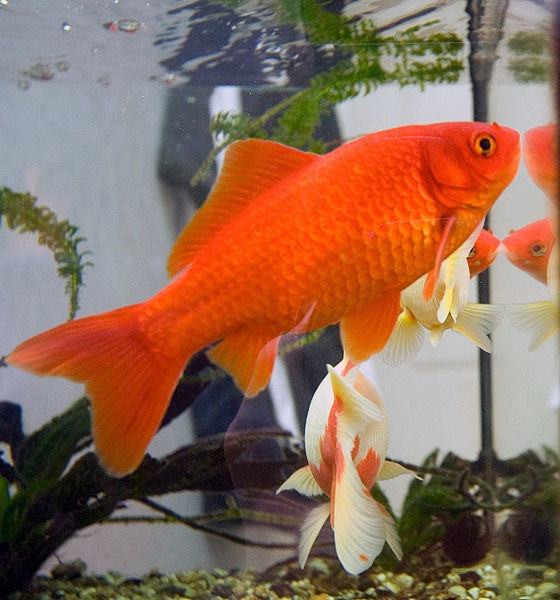Hey guys, Justin here! Its about that time of year when your pond may be turning into something resembling large vat of pea soup. The water turns green, the liner turns green, and thick green strings of algae grow on everything! It’s painful to see, because you work so hard on your pond to keep it nice, clean, and clear. Though I recommend using algaecides only as a last resort, it is very important to ensure that you are using them correctly if you choose to go that route.
The first thing to know when treating your pond is the size of you pond in gallons. This is imperative, as over dosing algaecides can kill ornamental plants, frogs, snails, and even fish. Under dosing, while not harmful, is wasteful and will obviousle make the product less effective in combatting the algae. If you are not sure of how many gallons your pond holds, there are many formulas to help you determine the volume. Rectangular ponds use the formula Length x Width x Average Depth x 7.5, Circlular ponds Width x Depth x 70.5. Make sure that all of your measurements are in feet. Oddly shaped or angular ponds may be a little tricky, but generally you want to calculate using the surface area x the average depth. Once you have the volume of your pond calculated, simply follow the directions based on the manufacturers suggested doses.
Once you have added the algaecide to the pond, it is important to remember the last half of algaecide is “cide”. This means that algae will in fact die, and those of us that have kept ponds and aquariums know that dead organisms left in water start to break down. As the dead algae is being broken down by bacteria in the water, Ammonia and CO2 will be released into the water. Ammonia is very toxic to fish even at low levels. It is important to add bacterial additives to your water in conjunction with algaecides. The additional bacterial additives will convert the excess Ammonia to less toxic nitrite, then again into nitrate.
As the bacteria are breakdown the dead algae, they also release CO2. As the CO2 is released, it will actually force the available oxygen out of the water. When treating your pond with an algaecide, it is very important to have adequate aeration and surface agitation to supply your fish with vital oxygen. This is especially important during the warmer water months, as warmer water tends to hold less oxygen than cooler water. CO2 build-up in conjunction with the demize of oxygen contributing (and unsightly) algae, will cause an instant drop in available dissolved oxygen! Be aware of treating in the evening, too. Oxygenating plants will not produce as much oxygen in the evening and through the night. Even if you have bunches of oxygenating plants in the pond besides the algae, fish may still suffocate if the pond is treated late in the day. It is best to treat early in the day when you are able to observe how your animals are responding and take steps if necessary to add more aeration. (Low oxygen levels may cause fish to become sluggish, listless, or cause them to gasp at the surface or congregate at a fountain head or waterfall where more oxygen is available.)
Remove dead and decaying algae as much as possible, before it begins to cause other problems. Once the algaecide has run its course, it is recommended that you do a water change to remove the remaining algaecide and free floating algar, and vacuum the pond bottom to remove the debris. There are also a variety of “sludge removers” to help breakdown the remaining debris before problems begin.
Following these simple steps and precautions will ensure that your pond remains clean and clear and help you to avoid any algaecide caused fatalities (except the nasty green invader). Good Luck and happy pond keeping!
 One of my first ever experiences with fishkeeping was with a goldfish won at a carnival – I thought it looked hungry and dumped an entire container of fishfood into the bowl. At a recent family picnic, I found a pretzel in the top of my small freshwater system courtesy of my four-year-old nephew and after a lesson on not feeding Aunt Eileen’s fish when she isn’t in the room, we all realized that the cycle is truly continuing (especially since that particular nephew loves to check my aquarium maintenance skills and point out all of the spots of algae I missed). I can’t wait until he has long enough arms for me to put an algae scrubber in his hand.
One of my first ever experiences with fishkeeping was with a goldfish won at a carnival – I thought it looked hungry and dumped an entire container of fishfood into the bowl. At a recent family picnic, I found a pretzel in the top of my small freshwater system courtesy of my four-year-old nephew and after a lesson on not feeding Aunt Eileen’s fish when she isn’t in the room, we all realized that the cycle is truly continuing (especially since that particular nephew loves to check my aquarium maintenance skills and point out all of the spots of algae I missed). I can’t wait until he has long enough arms for me to put an algae scrubber in his hand. That Fish Blog – Aquarium Advice and Information
That Fish Blog – Aquarium Advice and Information



